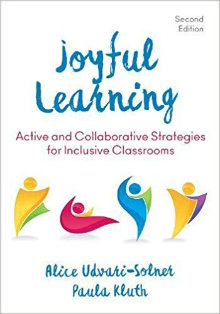Active Strategies for Inclusive Classrooms
Joyful Learning: Active and Collaborative Strategies for Inclusive Classrooms, 2nd edition
By Alice Udvari-Solner and Paula Kluth
(Corwin Publishers, 2017 – Learn more)

Teacher collaboration seems to be one of the buzzwords at the moment. There is a push from administration to strengthen the bonds through academic disciplines, academic teams, and in the inclusion classes. Many times there is little instruction on how to implement collaboration in an inclusion classroom, and there are sometimes hurt feelings and damaged egos because of it.

From the very beginning of the book, Udvari-Solner and Kluth discuss and illustrate the importance of developing a strong bond between co-teachers. This bond needs to extend beyond a superficial friendship because there must be trust between the individuals so there is comfort with teaching each other’s students.
Essential ideas to support co-teaching
The text is beautifully arranged in a logical manner with lesson ideas, lesson outlines, and reflection pieces to be used by teachers who are lucky enough to have this text. There is a theme to each chapter (e.g. Building Teams and Classroom Communities, Teaching and Learning, Studying and Reviewing, Creating Active Lectures, and Assessing and Celebrating) which makes navigating the book extremely simple.
The preface offers suggestions on how to use the book to one’s best advantage, and there are guiding questions to use when reviewing how the implementation went. For some lessons, there are reproducible handouts included. Many lessons also include ways to extend the learning opportunities for those students who need more. The authors also include ideas for varying the lessons for ease of use.
Included with the preface is a reproducible handout (Active and Collaborative Learning Structures, pg. xv) for students to complete which helps both the educator and the student identify which structure was used (with a given lesson) and how effective they believe it to be. This allows educators to formatively assess the interest levels, engagement, and comprehension of each lesson, and could be used as an exit ticket for a culminating activity. There is also a quick chart (Using Active and Collaborative Learning: Quick and Easy Ways to Differentiate and Design Lessons for All, pg. xvi) which could be copied and enlarged for planning purposes within a collaborate group or academic team.
Lessons reaching learners at all levels
Each lesson includes a brief outline of the lesson plan, directions for implementation (with examples), and methods to assure maximum engagement and participation.” This last piece is, perhaps, the most valuable because engaging students in lessons is often the main struggle.
For inclusion classrooms it is important to get all students engaged, while not spotlighting the students with IEPs. No student should be singled out for their ability, or lack thereof, as they participate in classroom activities. This book gives ideas for lessons that will reach a variety of learners at all levels.
At the end of each lesson idea is a space to reflect on ways to implement the lesson in one’s own classroom and to reflect on how the lesson went after implementation. The reflection invites the teacher to review the lesson components, how well it was received by students, and if it can be used again, perhaps with modifications.
The book does not explicitly state which grades it was written for, but the ideas offered by Udvari-Solner and Kluth could be easily modified for a group of students younger than middle school.
Essentially, this book is a useful tool for building stronger educator-educator, student-student, and educator-student relationships, creating a community committed to working together to help make students the most successful they can be. It’s a great source for ideas on how to move beyond the superficial and towards more meaningful engagement to get every student to reach their potential.
Erin Corrigan-Smith is a middle school ELA teacher in a suburb of Atlanta. She has a B.A. and M.A. in English and her focus of study is children’s literature. During the school year, she is faculty advisor to both the cooking and drama clubs. In her downtime, she enjoys going to her family’s cabin in the North Georgia mountains with her husband and dog to read and relax.



































